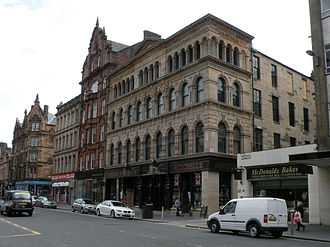Thomas Gildard

Thomas Gildard (nicknamed Gildey) was a 19th-century Scottish architect and author. He is notable as the co-creator of the Britannia Music Hall, Britain's first purpose-built music hall.
Life
His family were from Luss near Loch Lomond but he was born in a cottage hospital at Bonhill to the south. His father John Gildard owned a local hotel.
In December 1838 he was articled to David Hamilton in Glasgow to train as an architect.
He entered a partnership with his brother-in-law, Robert Macfarlane, in 1852, who had married his sister Eliza. Sadly both Eliza and Robert died of consumption in 1862. Gildard then went into partnership with John Carrick, who had recently become Glasgow's Master of Works.
His work began to concentrate on his writings rather than his buildings. He is noted for a strong condemnation of Presbyterian Gothic in his paper "Church Architecture" of June 1856, and for strong condemnation of the National Monument Committee in their treatment of his lifelong friend, John Thomas Rochead, in relation to the committee's failure to pay Rochead for his work on the Wallace Monument.
He was a friend of Alexander "Greek" Thomson and the Mossman family.[1]
He died of bronchitis at home, 133 Berkeley Street, Glasgow, on 5 December 1895.
He is buried in Glasgow Necropolis, his monument being designed by the Mossmans with a low-relief portrait head by William Shirreffs.[2]
Architectural Works
- Clyde Thread Works, Glasgow (1854)
- Housing, Belgrave Terrace, Glasgow (1856)
- Brittania Music Hall, Glasgow (1857) (with R Macfarlane) built as "Campbell's Music Salon"
- Surgeons Hall, Anderson's University
Written Works
see[3]
- Architectural Excursions (1867)
- Obituary to Alexander "Greek" Thomson in "Building News", 26 March 1875
- Mr Alexander Thomson, British Architect (1875)
- Memoirs of John Carrick (1890)
- Memoirs of Alexander Thomson (1890)
- Memoirs of John Mossman (1892)
- An Old Glasgow Architect on Some Older Ones (1895)
References
- ↑ Dictionary of Scottish Architects: Gildard
- ↑ Tim Gardner - Webmaster. "Gildard & Macfarlane (fl. 1853-1862), architect, a biography". Retrieved 4 January 2015.
- ↑ Dictionary of Scottish Architects: Gildard
- Buildings of Scotland: Glasgow by McWilliam Gifford and Walker